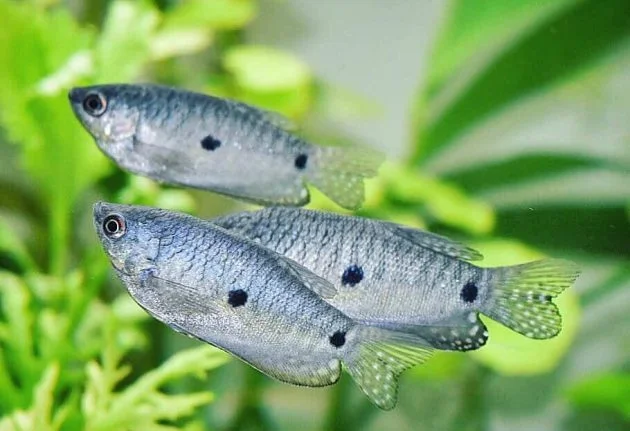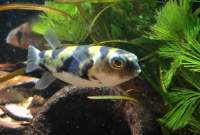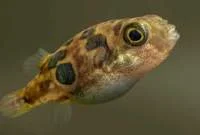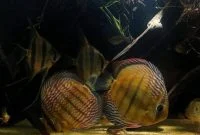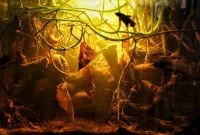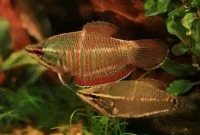Three Spot Gourami Fish Species Complete Profiles – Trichopodus Trichopterus, also known as three spot gourami (previously Trichogaster Trichopterus), is another popular freshwater gourami type. These fish are also known as blue gourami, gold gourami, and opaline gourami.
They originate from the river in Myanmar, Cambodia, Thailand, Laos, Vietnam, Malaysia, Northern Indonesia, and Southern China. Now, these fish was introduced to almost all countries in the world.
They tend to live in the slow-moving lowland streams and heavily-vegetated including marshes, ditches, swamps, and ponds. Some populations in central to lower Mekong river known to migrate during the wet season into flooded places of forests or grassland. And then returning to the main rivers when floodwaters begin to recede.
As we know, T. Trichopterus are popular fish around the fish keepers, and it should not be hard to find these gourami species in the trades. They generally need cost around $6 for healthy single fish. You can find them online, in-store, or with fellow hobbyists.
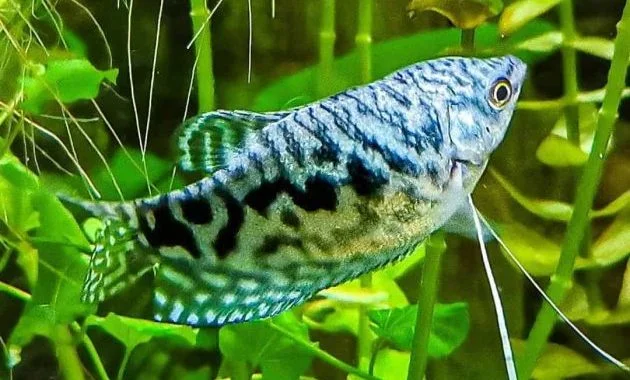
Three Spot Gourami Fish Species Complete Profiles
Three Spot Gourami Appearance
There are 3 types of three spot gourami varieties that often seem in the trades. The first variety is “opal” or “opaline gourami” or “marbled gourami” or “Cosby gourami,” which has a silvery-blue base color with some awesome deep cobalt blue splotches over their bodies and show unique marbling effects.
The second variety is blue gourami with a silvery-blue main color and smooth marbling with shades of lighter blue. Their color can become deeper based on their moods and times of breeding. Another feature of them is two dark spots. One is located in front of the tail and the other in the center of the body. Although the common name of them are three spot gourami, just two visible spots, and the third is actually their eyes. Some of them may have some yellow flecks here and on their fins.
The last is “golden gourami” or “gold gourami,” a more vibrant colored variety than the other. They have attractive gold-tone and deeper toned lined patterning along the backside. This gourami species do not have the two dark spots on their body.
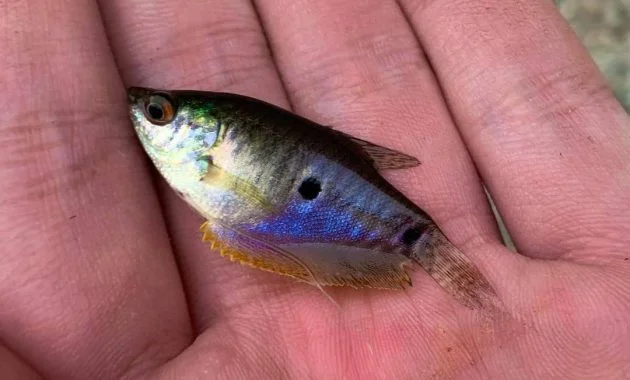
While the wild form of three spot gourami has a brownish-colored body with yellow on the gills, cover until the belly, and marked with irregular darker stripped on the shoulder area. By selectively crossbreeding in captive, these fish have another variety: platinum and lavender (amethyst) varieties.
These gourami species have the same profile as other gourami families; their bodies are flat with large rounded fins. They have pectoral fins like needles and expansive anal fins.
Sometimes it’s quite hard to distinguish between males and females. But, you can observe the females by their dorsal fins. They tend to have shorter rounded dorsal fins. In comparison, the males’ dorsal fins are long and pointed. Besides, females more seem a bit fuller when breeding season.
Trichopodus Trichopterus can grow to reach up to 6 inches (15 cm), but most aquarium specimens tend to grow smaller than this. Their expected lifespan is about 4 – 6 years; they may live slightly longer in a good living environment.
Read Also: Freshwater Paradise Gourami Complete Care Guide
Three Spot Gourami Behavior And Temperaments
The three spot gourami have labyrinth organs that allow these fish to absorb the oxygen from the air. They tend to swim in the upper and middle areas of the aquarium. So you can see them swimming to the surface to take a breath from time to time!
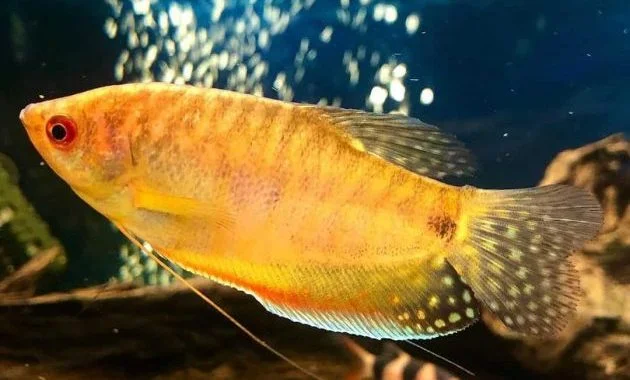
Buy The Golden Three Spotted Gourami Only On eBay
The three spotted gourami species are quite peaceful and can put in the community tank, but sometimes you may see them in-fighting with pairs or groups. The males occasionally become a bit territorial, especially in smaller aquariums. After breeding, males will become more aggressive to the females or other species around them.
They are so active, and you can find these tropical fish playfully swimming and exploring all areas in the aquarium. Sometimes, they will nip at aquarium plants to eat some algae. They will show you an interesting show and never make you bored.
Read Also: Chocolate Gourami “The Unique Mouthbrooding Gourami Species”
Three Spot Gourami Housing, Aquarium Setup, And Care
As other small-medium gourami fish species, they are quite calm and can be put together with other species in a community tank, in a small group, in pairs,s or solo.
You will be needed at least a 30-35-gallon size for tiny adult groups or single fish. You can also use 20 gallons for juveniles, but when they grow bigger, you should move them to the larger aquarium to accommodate their strong swimming habits and playful behavior. If you want to keep them in the community tank, recommended using at least a 50-gallon tank size or more to give more swimming space.
Design your tank similar to their natural environment, and it is the best condition to make them happy living in the aquariums. Choosing dark-colored substrates, texture, and color is not important, and you can use gravel or sand. For example, you can use “Flourite Black Sand“. The black color from it can help pope their coloration and shine in the tank.

Next, adding some live aquarium plants to the aquarium. Putting your favorite plants is a good choice. We recommend planting hardy freshwater plants like anubias species, Sagittaria subulata, or some aquarium lilies. Covered the water surface with floating plants like Azolla Cristata, offering more shading areas similar to their wild environments. But do not overcrowd the aquarium surface with it; these fish need access to the surface to take a breath.
To push the natural appearance, you can add stones, driftwood, or caves. It also offers more hiding and playing places for these gouramis.
Using a high-quality and efficient filtration system to keep the waters in good conditions. Ensure to keep the water flow relatively slow, and these fish are not used to fast currents. Add some airstone to enhance the oxygens level is a good idea, but that is not necessary if you are planting enough aquarium plants. The standard lighting system is allowed, or you can use dim lighting which following their natural habitat.
The ideal water conditions to keep them in the tank should be following the rules below:
- Temperature Level: 24-30°C (75-86° F)
- pH Level: 5.5-8.5
- Water Hardness Level: 5-35 dGH
Read Also: The Ultimate Kissing Gourami Fish Care Sheet
Three Spot Gourami Tankmates
Three spotted gourami types are hardy fish and easiest to care for to make them ideal for beginner fish keepers. The three spot gouramis are moderately aggressive, so they need the right species for their tankmates.
Their friends should behave in similar characteristics. The larger or smaller fish species must be avoided. The larger fish can be bullying the three spot gourami, and smaller fish may be eaten by them as a snack.
The aggressive and territorial fish species must be avoided. They may create some brawl and spark to fighting with three spot gourami.
It’s some samples of a few good tank mates that coexist with the three spot gouramis:
- Peaceful catfish species
- Loaches species
- Larger and peaceful tetras species
- Other similar-sized gouramis (Such as dwarf gourami and honey gourami)
- Characins
- Peaceful barbs
- Bigger snails or shrimps
Read Also: The Ultimate Kissing Gourami Fish Care Sheet
Three Spot Gourami Feeding And Diet
In the wild habitat, three spotted gourami is actually an omnivore. The Trichopodus Trichopterus almost allow many smaller invertebrates, algae, zooplankton, and larvae. They may accept any dry foods from the store in the aquarium, like fish pellets and algae-based flakes.
Although, you should be supplemented them with higher-quality food as well. It can enhance their coloration, growth, and health level. The three spot gourami fish will be enjoyed when you give them live or frozen snacks such as tubifex worm, bloodworms, shrimp meats, brine shrimps, and other great choices. They also accept the vegetables like blanched lettuce.
Read Also: Complete Tropical Pearl Gourami Fish Care Sheet
Three Spot Gourami Breeding
Breeding the three-spot gourami is the same as most other fish species under the osphronomidae family. They are great bubble nester builders. Before breeding, feed the fish with live food in small portions several times a day. It can stimulate them to breed.
First, you should prepare a breeding aquarium size of 10-20 gallons. The water level is about 5-6 inches. Using a peat or sponge filtration system to minimalize the water disturbance. Keep the water temperature level around 80 degrees Fahrenheit. Add some floating plants and longer-stemmed freshwater aquatic plants.
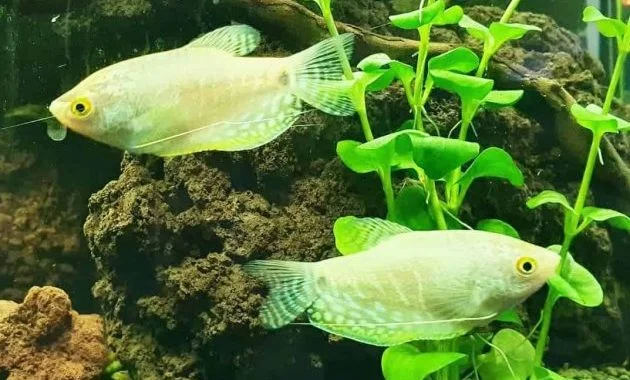
The male three spot gourami will build the bubble nest before spawning, and it generally occurs early in the day. When the nest is prepared, the male will try to court the female by swimming back and forth, raising his tail, and flaring his fins. The female three spot gourami will respond by biting his back.
During spawning, the male wraps the female body tightly. At the same time, females will release the eggs, and males fertilized them soon. Eggs automatically float to the nest. The pair collects the stray eggs and saving them to the nest.
The pair may repeat this process many times until the female spent all her eggs. For your information, female three spot gourami can lay up to 800 eggs.
Once the spawning process is over, the female three spotted gourami can remove from the breeding tank. The Male will guard the eggs until they are hatching. Generally, eggs will hatch in approximately 30 hours. When they are fully hatching, the fry will get out soon from the nest and become free-swimming. This moment is good to move the male to avoid the fry eaten by him.
The free-swimming fry can be fed with infusoria until they grow large enough to accepts brine shrimps or artemia.

